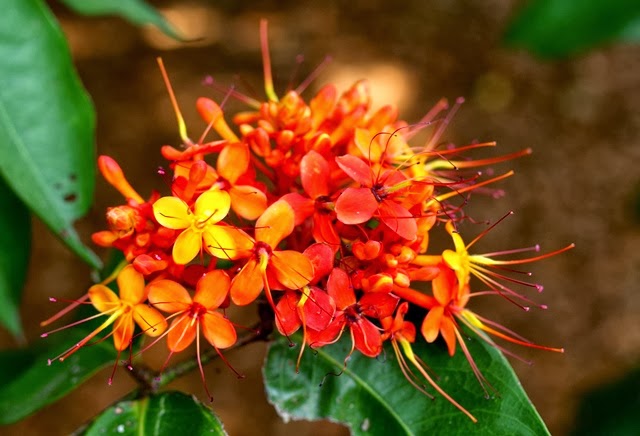Saraca's petal-less flowers confuse but are from the heartwood
More botanical highlights from Singapore. When I was visiting in February, Saraca was one of the most colourful and plentiful trees in flower. The clusters of mostly yellow, orange or red flowers erupted from all over the plant, all over the city.
The species photographed here is from the Singapore Botanic Gardens and is called botanically Saraca cauliflora (previously Saraca thaipingensis) in celebration of one place the flowers arise - from the trunks and stems ('caulis' is Latin for stem) - and commonly, the Yellow Saraca, in recognition of their colour (at least when young).
The Yellow Saraca is a local plant, native to the Malay Peninsula as well as further afield in the Indochina region and as far south as Java. There is a stream named after Saraca running through the Singapore Botanic Gardens. Along with the Yellow Saraca you can see the Red Saraca, Saraca declinata, and sometimes their roots trailing in the water (like weedy willow roots in many Australian streams).
Both these species, along with 70 or so others in the genus Saraca, are in the family Caesalpiniaceae (sometimes treated as part of the broader pea family, Fabaceae, which all bear their seeds in pods). Like me, you are probably more familiar with members of this family such as Cassia, Senna, Gledistia or Bauhinia.
Oddly, and unusually for this family, the flowers of the Saraca have no petals: normally it's the slightly irregular (actually bilaterally symmetric) display of petals that usually gives away the identity of a 'caesalpin'. In Saraca, the yellow or orange coloured segments are actually the outer layer of the flower, the sepals, folded back on the top of a narrow tube. The male bits, like your typical caesalpin, however, are sticking out strongly.
The flowers had little perfume in the stinking hot day I visited them, but I gather they do their thing at night. Evening perfumes are usually for bats or moths. The flowers are too small for nectar-eating bats I think and the colours too gaudy for moths - they start bright yellow and finish bright orange or red. More likely it's the birds that pollinate them, perfume or not, and plenty of nectar-feeding local species are attracted to them.
The leaves are divided up into matching pairs of leaflets and when young can have a gorgeous pinkish hue. It wasn't quite the season for new growth, but the pods are just as dramatic: large, flat and purple.
We can't, or at least we don't, grow Saraca outdoors at Melbourne's Royal Botanic Gardens. It doesn't like 'the cold'. While not the closest place to see them, I can recommend both Singapore Botanic Gardens and Gardens by the Bay, in February, for a memorable Saraca display (but no means done any credit but this photo of one of the larger trees I saw, in the botanic garden).
Images: All but the second picture are from a specimen labelled Saraca cauliflora, and had yellow flowers that turned to orange. The other one, labelled Saraca thaipingensis, seemed to have entirely yellow flowers.





Comments